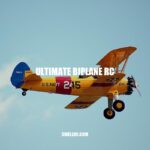Slick RC Plane: A Versatile and Exciting Radio-Controlled Aircraft
The Slick RC Plane is a popular radio-controlled aircraft that has taken the hobby world by storm. With its sleek design, aerodynamic features, and impressive performance capabilities, this flying machine has won the hearts of many pilots and enthusiasts. Developed by 3D pilot and designer Gary Wright, the Slick RC Plane is built to deliver an unforgettable experience in the skies. It is a remarkable aircraft that is designed to perform impressive stunts, tricks, and maneuvers with ease. Whether you are a beginner or an expert, the Slick RC Plane is an excellent choice for anyone looking to experience the excitement of radio-controlled flight. In this article, we will explore the features, design, performance, and tips for flying the Slick RC Plane, so you can learn more about this fantastic machine and how to fly it safely and confidently.
Design and Features of the Slick RC Plane
The Slick RC Plane is built using a combination of balsa wood and carbon fiber, making it lightweight yet durable. It has a symmetrical airfoil design, which makes it suitable for performing aerobatics and stunts in mid-air. Here are some of the features of this remarkable aircraft:
- Aerodynamic design that reduces drag and enhances performance
- High-quality balsa and carbon fiber construction ensure durability and longevity
- Symmetrical airfoil design that makes it easy to perform stunts and tricks
- Powerful electric motor that delivers ample power for high-speed flights
- Responsive control system that allows for precise movements and flight control
- Advanced 3D flight capabilities, including hover, torque rolls, and knife-edge flights
The Slick RC Plane is available in different models and variations, each with its unique features and designs. Some popular versions include the 48″ Slick 540, 59″ Slick 540, and 70″ Slick 580. In addition, there are many online websites, forums, and communities dedicated to RC plane enthusiasts, where you can find more information, tips, and advice on flying the Slick RC Plane. Some popular sites include RCGroups.com, FlyingGiants.com, and RCUniverse.com.
How to design a RC plane?
Designing a RC plane is a complex process that requires a deep understanding of aerodynamics, materials, and electronics. Here are some basic steps to help you get started:
1. Decide on the type of plane you want to design – glider, trainer, aerobatic, or scale model.
2. Research and gather information about aerodynamics, dimensions, and materials used in designing RC planes.
3. Draw a preliminary sketch of your RC plane design and make a list of all the components required such as wings, fuselage, tail, and control surfaces.
4. Then, create a 3D model of the RC plane design using CAD software and run simulations for aerodynamics and stability.
5. Choose the materials according to the design specifications and calculate the weight and CG of your RC plane.
6. Choose the suitable power system, servo, and RC transmitter and receiver that will be used in the RC plane.
7. Finally, build the RC plane according to the design and test fly it to check its aerodynamics and stability.
There are many websites and products available for RC plane designing that can help in the process such as Flite Test, RC Groups, and RC Universe. Additionally, CAD software such as Fusion 360 and SketchUp can help in creating 3D models for RC plane design.
The Slick RC Plane is a versatile aircraft capable of performing a wide range of flying styles, from slow-paced flight to aerobatics and stunts. It has a relatively low stall speed, allowing the pilot to fly at slow speeds without losing control. Here are some of the performance and flight capabilities of the Slick RC Plane:
- Top speed of up to 100mph for high-speed and racing flights
- Ability to perform 3D maneuvers such as hover, torque rolls, and knife-edge flights
- Smooth and stable flight characteristics that make it easy to fly and control
- Can perform rolls, loops, and inverted flights with ease
- Ability to fly in tight spaces and maneuver in small areas
In addition to its impressive performance and flight capabilities, the Slick RC Plane has also been used in various competitions and events worldwide. For instance, the North American Slickfest is an annual competition that brings together Slick RC Plane enthusiasts from around the world to compete in various aerobatic challenges. The competition features participants flying the Slick RC Plane to perform various stunts and maneuvers in the air, showcasing the aircraft’s impressive capabilities.
Table 1: Comparison of different Slick RC Plane models
| Model | Wingspan | Length | Weight |
|---|---|---|---|
| 48″ Slick 540 | 48 inches | 44 inches | 2.5-3.5lbs |
| 59″ Slick 540 | 59 inches | 55 inches | 5-6lbs |
| 70″ Slick 580 | 70 inches | 68 inches | 9-11lbs |
What are the aerodynamics of RC planes?
The aerodynamics of RC planes involve different concepts such as lift, drag, thrust, and weight. Some factors that affect the aerodynamics of RC planes include the wing shape, airfoil profile, aspect ratio, and the center of gravity.
To achieve better aerodynamics, RC plane enthusiasts can modify their planes by adjusting the control surfaces, wing configuration, and wing loading. They can also choose different types of propellers and motors to improve the plane’s performance.
There are several resources available for those interested in learning more about the aerodynamics of RC planes, including online forums such as RCGroups.com and RCUniverse.com. Additionally, products like the RealFlight RC flight simulator can help pilots learn and practice maneuvering their planes in different aerodynamic conditions.
Here is a summary of the aerodynamics of RC planes:
| Concepts | Factors that affect aerodynamics |
| Lift | Wing shape, airfoil profile |
| Drag | Aspect ratio, control surface adjustments |
| Thrust | Propeller type, motor type |
| Weight | Center of gravity, wing loading, wing configuration |
- Resources for learning more about RC plane aerodynamics: RCGroups.com, RCUniverse.com
- Product for practicing RC plane aerodynamics: RealFlight RC flight simulator
Tips for Flying the Slick RC Plane
Flying an RC plane can be a fun and exciting experience, but it also requires practice and patience. Here are some tips for flying the Slick RC Plane safely and with confidence:
- Start with small, controlled flights, and gradually progress to more advanced maneuvers as you gain experience.
- Choose an open area with no trees, buildings, or power lines nearby to avoid accidents and crashes.
- Check the weather conditions before flying, and avoid flying in windy or rainy conditions.
- Inspect the plane before each flight, checking the battery, motor, and control surfaces for damage or signs of wear and tear.
- Practice different maneuvers and stunts in a simulator before attempting them in real life, to gain confidence and improve your skills.
- Join a local RC club or community to connect with like-minded enthusiasts and get advice and support.
In addition to the above tips, there are several online resources available for Slick RC Plane enthusiasts. Websites such as RCGroups and FlyingGiants offer forums, tutorials, and reviews of different Slick RC Plane models and accessories. You can also find a range of products specifically designed for the Slick RC Plane, including replacement parts, batteries, and propellers.
Table 2: Top Accessories for the Slick RC Plane
| Accessory | Description | Price |
|---|---|---|
| Lipo batteries | High-performance batteries that provide more power and longer flight times | $30-$50 |
| Carbon fiber propellers | Lightweight and durable propellers that enhance the plane’s performance and speed | $10-$20 |
| Servo motors | High-quality motors that enhance the plane’s maneuverability and control | $20-$40 |
What is a good tip for flying RC planes?
A good tip for flying RC planes is to start with a high-wing trainer model, which is more stable and easier to control. Additionally, avoid flying in crowded areas or close to buildings and power lines. Here are some other tips:
- Check the weather conditions before flying. High winds can make it difficult to control the plane.
- Make sure your plane is properly balanced and that the control surfaces are properly aligned.
- Practice on a flight simulator before flying a real plane. This can help you get a feel for the controls.
- Always keep your eyes on the plane and be ready to make adjustments if needed.
- Invest in a good quality transmitter and receiver to ensure a reliable and consistent signal.
If you’re looking for more tips and advice, there are several websites and forums dedicated to RC plane flying, such as RCGroups.com and FliteTest.com. You can also find various RC plane models and equipment on sites like Amazon.com and HorizonHobby.com.
If you are an RC plane enthusiast or just someone looking for a new and exciting hobby, the Slick RC Plane is definitely worth considering. Its sleek design, powerful motor, and responsive controls make it a versatile and highly capable aircraft perfect for performing a range of stunts and aerial tricks. With a little practice and patience, you can learn to fly the plane confidently and safely, making it a great way to spend your free time.
Joining an RC club or community is an excellent way to connect with other Slick RC Plane enthusiasts and to learn more about flying this type of aircraft. You can also find a wealth of online resources, such as forums, tutorials, and user reviews, to help you choose the best model and accessories for your needs.
In conclusion, the Slick RC Plane is a remarkable machine that combines style, performance, and maneuverability in one impressive package. By following the tips and advice mentioned in this article, you can learn to fly the Slick RC Plane safely and confidently and enjoy all the thrills and excitement that this hobby has to offer. So, why not take the leap and explore the exciting world of RC aviation today?



